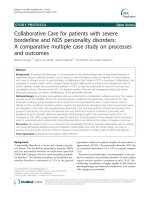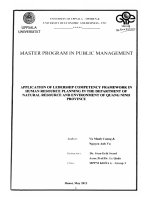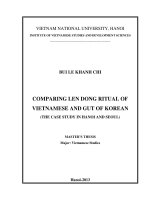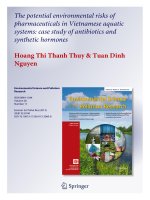Case Study: chinas resource and environment performance index
Bạn đang xem bản rút gọn của tài liệu. Xem và tải ngay bản đầy đủ của tài liệu tại đây (402.75 KB, 5 trang )
Low Carbon Green Growth Roadmap for Asia and the Pacific
CASE STUDY
Measuring eco-efficiency triggers a green transformation
China’s Resource and Environment Performance Index
Key points
•
China recognized the imperative of improving its eco-efficiency and decoupling economic growth
from its intensive coal and fossil-fuel consumption pattern.
•
The Government’s goal is to develop a Resource Efficient and Environment-Friendly Society. Through
the Resource and Environment Performance Index, the progress is monitored and evaluated.
There was an alarm…
For the past two decades, a rapid expansion of energy- and resource-intensive heavy industry fuelled China’s
economic growth – from 37 per cent of GPD in 1990 to 45.9 per cent in 2004. China’s energy and resource
demand has visibly risen in parallel, and by 2010 the country had become the world’s second biggest energy
consumer and CO2 emitter. The resource- and energy-intensive production and consumption of that speedy
growth also has resulted in significant social and economic costs. China is losing 4.3 per cent of its GDP to health
costs related to air and water pollution and 1.5 per cent from the non-health impacts of pollution. The value of
the negative externalities associated with coal production and consumption were estimated to be as much as
1.7 trillion yuan in 2007, accounting for 7.1 per cent of China’s GDP in that year.1
The concern about China’s growth pattern led to warnings that unless a shift is made from the high input, high
consumption, high pollution, low-output and low-efficiency growth model, the economy would overheat and
could threaten the long-term economic development.
What was done?
The Government sought to drive a paradigm shift towards resource and energy efficiency to sustain the growth
and development while responding to the shared responsibility of the global community in tackling the climate
and ecological challenges. To make this shift, the Government introduced the concept of a Resource Efficient
and Environment-Friendly (REEF) Society – a term adopted by the Chinese Academy of Science – and
integrated it into the Eleventh Five-Year Plan for National Economic and Social Development (2006–2010).
A comprehensive framework for both the macro and micro levels
Building a REEF society requires “real protection and rational use of various sources, raising the utilization
efficiency of resources in all areas of production, construction, distribution and consumption and in all aspects
of economic and social development so as to achieve the maximum economic and social benefits with as little
consumption of resources as possible”.2 A REEF society, also called an energy- and resource-saving society, has
two primary aspects: i) a range of integrated means to rationally relocate, recycle and reuse resources in a
highly efficient manner and ii) minimizing pollutant generation and other environmental impacts of production
and consumption.
The core values of a REEF society are resource and energy efficiency, pollutant discharge reduction and environmentally sound treatment of waste, prioritizing the saving of energy, land and water resources. Based on the
1
Mao Yushi, “The True Cost of Coal” (Greenpeace, China Sustainable Energy Program, WWF, 2008). Available from
(accessed 23 November 2011).
2
Wen Jiabao, “Give Full Attention, Strengthen Leadership and Accelerate the Building of an REEF Society (温家宝:高度重 加强
加快建
型社会) (Xinhua News Agency, 2005). Available from />(accessed 9 February 2012) (Originally in Chinese language).
Low Carbon Green Growth Roadmap for Asia and the Pacific : Case Study - China’s Resource and Environment Performance Index
macro framework, policy instruments and strategies were developed at the micro level, including various institutional arrangements, structural adjustments and technological innovations.3
Figure 1: Basic structure of REEF – the essential elements of a resource-saving society
Resource-saving society
National economic
system featuring
resource conservation
Resource-saving
agriculture
Resource-saving
industries
Resource-saving
construction
Resource-saving
consumption
awareness and
patterns
Resource-saving
transportation
Awareness
Promoting
resource saving
Resource-saving
service sector
Behaviour
Changing
consumption
patterns
Resource and Environment Performance Index: Measuring eco-efficiency
The REEF initiative stemmed from alarming research findings that indicated China’s resource and environmental
performance was significantly behind most industrialized countries. Developed by the Chinese Academy of
Science, the Resource and Environment Performance Index (REPI) is a relative indicator that reflects a country’s
(or a region’s) level of resource use, or eco-efficiency, by quantifying resource consumption and pollutant emissions per unit of GDP (box 1). REPI was developed to reflect, monitor and assess the progress of the installation of
a REEF society at international, regional and industrial levels.4
BOX 1: The Resource and Environment Performance Index5
Wi = The weight of resource consumption or pollutant discharge performance of resource i
Xij =The total quantity of resource consumption or pollutant discharge of resource i in province (or region) j
gj = The GDP (total) in province (or region) j
Xio = The total quantity of resource consumption or pollutant discharge of i in the country
Go = GDP of the country
g/x and G/X = The intensity of resource consumption or pollutant discharge that results in each province (or
region) (g/x) and the whole country (G/X)
n: the number of types of consumed resources or pollutants discharged
* The larger the number, the higher the REPI, and the higher the performance of the country or the province (or
region). For simplification, it is assumed that the weight of all resources and pollutant discharge results is identical.
Source: The information extracted from Chinese Academy of Science, China Sustainable Development Strategy Report 2011: Greening the
Economic Transformation
Low Carbon Green Growth Roadmap for Asia and the Pacific : Case Study - China’s Resource and Environment Performance Index
REPI findings – Wide discrepancies among countries and among regions within China
REPI calcuations found the wide discrepancies among countries and among regions within China.6 The following graph indicates that in terms of the level of resource intensity, however, the country steadiliy improved its
environmental performace between 2000 and 2009.
Figure 2: Changing trends of the REPI, 2000–2009
Source: China Sustainable Development Report 2001 and China Sustainable Development Report 2011, original in Chinese)
A 2003 REPI study calculated the resource-efficiency performance of 59 countries, based on the consumption
of five key resources (non-renewable energy, freshwater, cement, non-ferrous metals and finished steel). China’s
low performance ranking alarmed the Government (54th using GDP at purchasing power parity and 56th for
GDP at market rates), which initiated the revision of the existing pattern of growth. The findings also revealed that
China’s energy intensity had exceeded that of industrialized countries by 120 per cent. The comparisons among
countries indicated that, in general, a country at the lower level of development tends to have a low level of
resource efficiency and environmental performance than more advanced ones.
Comparison among different regions within China also indicated a significant disparity, with western China
following a more resource-intensive pattern of growth than the eastern side.
3
For more details of the policy measures, see ESCAP, Eco-efficiency: A Practical Path to Sustainable Development (2007) pp. 53-55
4
Room for further improvement of the REPI exists: Challenges in determining the kind and weight of resource and pollutant to be included
in the measurement, integrating REPI in the Government’s decision-making and policy process at all levels, as well as quantifying the
contribution of structural adjustments, technical innovation to resource and environmental performance are examples. See: Shaofeng
Chen and Yi Wang, REPI-Based Evaluation for Resource-Efficient and Environment-Friendly Society in China (Institute of Policy and Management Science, Chinese Academy of Sciences, Beijing). Available from
www.greengrowth.org/download/GGPD_CD_resources_for_website/SECTION_III_%20H_.pdf [Accessed 8 March 2012].
5
Chinese Academy of Science, China Sustainable Development Strategy Report 2011: Greening the Economic Transformation (CAS
Sustainable Development Strategy Study Group, February 2011, original text in Chinese). The definition of REPI has been modified. For the
original version of the formula, see CAS Sustainable Development Strategy Report, 2006.
6
For more deteails, see Chinese Academy of Science, China Sustainable Development Report 2006
Low Carbon Green Growth Roadmap for Asia and the Pacific : Case Study - China’s Resource and Environment Performance Index
Results
With the integration of the goal of a REEF society and introduction of the REPI in its Eleventh Five-Year Plan, the
Government initiated strategic adjustments for its new economic structure and transformation into more sustainable and greener growth. A recent assessment by the Chinese Academy of Science concluded that through
the Eleventh Five-Year Plan, China succeeded in integrating green and low-carbon policies into the country’s
development and growth by significantly raising the awareness of both the Government and society. The
nationwide efforts of energy-saving measures have led to visible results: In the first four years of the Eleventh FiveYear Plan, the country overachieved its intended target of energy savings by one third.7
Continuation and deepening of eco-efficient economy in the Twelfth Five-Year Plan
The Academy of Science studies generated a sobering realization that China’s extensive GDP growth was at the
expense of poor environmental and resource-efficient performance and that a better REPI level was impossible
to reach by following the resource- and energy intensive industrialization path.8
Carrying on from the previous plan for economic development, the Twelfth Five-Year Plan (2011–2015) emphasizes “higher-quality growth” and “inclusive growth”. As well, the Government prudently opted to slow growth to
a 7 per cent to enable quality and sustainable economic growth.9
Reducing emissions by increasing energy efficiency is a major focus, and new regulations, preferential and
industrial policies have been adapted to support the implementation. This includes binding targets on important
pollutants, such as nitrogen oxide and ammonia nitrogen, to improve the air and water quality. The Government
is now heavily promoting the “circular economy” (recycling) as an important strategy for national and social
development. Recycling in production, circulation and consumption is to be speeded up across the country to
improve the efficiency of China’s resources output ratio.
Among the seven priority sectors targeted for improvement in the Twelfth Five-Year Plan, three of them align
specifically the theme of sustainable growth: energy savings and environmental protection, new energy technologies and clean energy vehicles.10
To improve the resource and environmental performance, the plan also fosters a decrease of energy intensity
per GDP by 17 per cent and reduced carbon intensity for 2020 by 40 per cent from the 2005 levels. This goal is to
be achieved through the restructuring of the coal industry and the steady replacement of renewable energy,
which will also help to mitigate the environmental impact generated by the rising energy demand. The plan
highlights anticipated investments in clean coal technologies, such as hydropower, solar and wind capacities,
and the building of 200,000 kilometre-long high voltage power lines for transmitting the renewable energy from
the point of generation to grid centres.
7
See Chinese Academy of Science, China Sustainable Development Strategy Report 2011: Greening the Economic Transformation (CAS
Sustainable Development Strategy Study Group, February 2011). Available from www.world-governance.org/IMG/pdf_Wang_Yi__China_Sustainable_Development_Strategy_Report_2011.pdf (accessed 9 March 2012)
8
Shaofeng Chen and Yi Wang, Section III H: REPI-Based Evaluation for Resource-efficient and Environment-friendly Society in China (United
Nations Economic and Social Commission for Asia and the Pacific, 2007). Available from
www.greengrowth.org/download/GGPD_CD_resources_for_website/SECTION_III_%20H_.pdf (accessed 9 March 2012).
9
New Zealand Trade and Enterprise, Report On the 12th Five Year Plan (Auckland, 2011). Available from www.nzte.govt.nz/featurescommentary/In-Brief/Documents/China%27s%20%20Five-Year%20Plan%202011-2015.pdf (accessed 9 March 2012).
10
KMPG China, China’s 12th Five-Year Plan: Overview (Beijing, 2011). Available from
www.kpmg.com/CN/en/IssuesAndInsights/ArticlesPublications/Publicationseries/5-years-plan/Documents/China-12th-Five-Year-Plan-Overvi
ew-201104.pdf (accessed 9 March 2012).
Low Carbon Green Growth Roadmap for Asia and the Pacific : Case Study - China’s Resource and Environment Performance Index
Further reading
China Sustainable Development Strategy Report 2011: Greening the Economic Transformation (Chinese Academy of Science, Sustainable Development Strategy Group, February 2011), Available from www.worldgovernance.org/IMG/pdf_Wang_Yi_-_China_Sustainable_Development_Strategy_Report_2011.pdf
Eco-efficiency: A Practical Path to Sustainable Development (UNESCAP, 2007)
Report On the 12th Five Year Plan (Auckland, New Zealand Trade and Enterprise, 2011). Available from
www.nzte.govt.nz/features-commentary/InBrief/Documents/China%27s%20%20Five-Year%20Plan%202011-2015.pdf
Shaofeng Chen & Yi Wang, REPI-Based Evaluation for Resource-Efficient and Environment-Friendly Society in
China. Institute of Policy and Management Science, Chinese Academy of Sciences (Beijing 100080, P.R. China)
Available from www.greengrowth.org/download/GGPD_CD_resources_for_website/SECTION_III_%20H_.pdf









